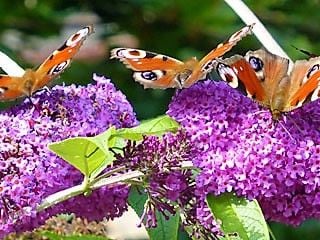
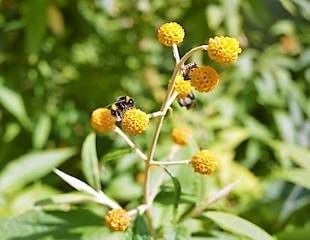
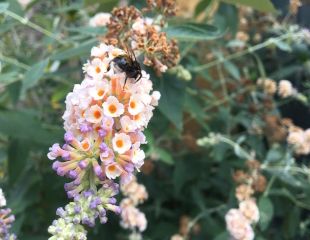
How to grow Buddleja (Butterfly Bush)
Buddleja is an easy to grow, fully hardy summer flowering deciduous shrub. It does well in a sunny spot and is usually disease free and low maintenance.
There are evergreen varieties of Buddleja, the usual varieties on sale and growing in the UK are
- B. globosa, illustrated in the centre image,
- B.alternifolia, B.davidii and
- Buddleja x weyeriana far right illustrated is 'Moonlight".
B.weyeraina is a cross between Buddleja davidii Magnifica and Buddleja globosa. I think Moonlight, illustrated, is the most attractive with mauve flowers turning a delicate shade of peach. There is also " Sungold" a predominantly yellow variety, and "Golden Glow" a mix of the two.
The most commonly grown is B.davidii (image above left) which is deciduous, and fast growing. It makes a large shrub, up to 2.5-4m with 5m spread. This means it is not suitable for all gardens, being too large, and check out (below the compact varieties)
Buddleja has panicles of aromatic flowers attractive to insects and butterflies. Each panicle has hundreds of tiny flowers and the flower panicles are large so that a Buddleja in bloom is a showy sight. Buddleja is a magnet for pollinators and butterflies. Buddleja will attract many butterflies, in the image left a single panicle has 3 butterflies on it.
An excellent butterfly plant combination is Buddleja with Oregano and Sedum, which will create a butterfly paradise.
Growing and planting Buddleja
Buddleja flower best in a sunny spot, which is also where butterflies like to find them. The only maintenance required for Buddleja is an annual prune to keep Buddleja in check, and flowering well. Suitable for almost anywhere in the garden, Buddleja will grow in all soil types, and does especially well on chalk and lime soil. Easy to grow even on poor soil.
There is a significant variety in the size of Buddleja; the popular 'Black Knight' spreads quickly and can reach 3 meters. There are many compact and patio varieties, such as B. 'Nanho Blue'. Check out the overall size of the shrub to make sure there is plenty of room to expand after planting.
Recently Buddleja has had bad press as being invasive, because it does self seed, and this can be a problem if your garden is near an area of natural beauty or conservation. If this is a concern, dead-head the flowers, which will prevent it from setting seed.

This denotes RHS award of garden merit always a good starting point when selecting a shrub or plant.
How to prune Buddleja
Buddleja davidii will flower best if it is hard pruned in late winter or early spring, around late Feb/March time. Prune to around 30-60cm down to woody framework, which also helps to check its overall size. It will look sparse when first pruned, but it is best to be bold and it will spring back into life and shoot up. Prune Buddleja davidii when the worst of the weather is over. Pruning Buddleja is not essential, the shrub will survive if not pruned, but pruning produces the best flowers and keeps it to size.
The other common types of Buddleja, B. alternifolia and B. globosas are pruned differently because they flower on "old wood" . If pruned in early spring, this would result in cutting off the stems carrying the flowers. For these types of Buddleja all that is required is a light prune after flowering, mid summer onwards.
This means for pruning purposes, the different types of Buddleja need to be distinguished.
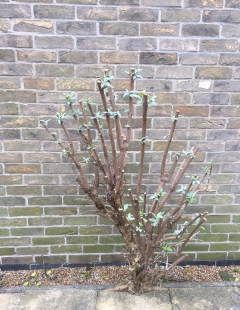
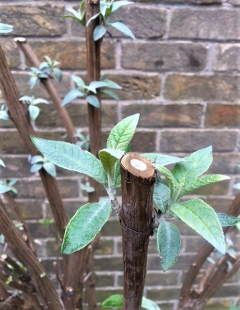
Buddleja davidii after Pruning
For pruning purposes, how to tell which Buddleja you have?
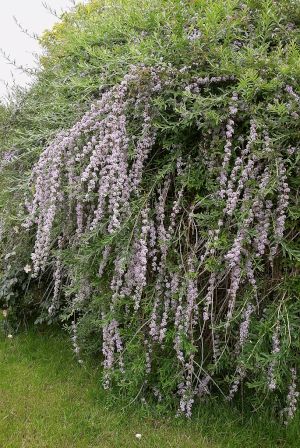
The flowers on buddleias davidii and alternifolia are similar. The difference is that b. alternifolia has alternate leaves. In addition, it has a distinct weeping shape, and its flowers are light mauve, appearing in late spring and early summer. The leaves have a silver tinge and it is less common than B. davidii.
B.davidii flowers later in the year, from July/August onwards, and flowers in many colours which include light mauve, but also many shades of purple, dark purple, red, and white.
It is arching in habit as compared to weeping. If you are not sure which Buddleja you have in your garden, the flowering time is the best indicator.
Best Varieties of Buddleja to Grow
Buddleja has many attractive flowering colours all ranging around mauve, pink, purple and white and well-known varieties are: B 'Black Knight' which is dark purple, 'White profusion,' 'Harlequin' pink which also has variegated leaves, and 'Empire Blue'. All Buddleja davidii are fragrant. B Buddleja alternifolia, which is also deciduous, and has lovely scented lilac coloured flowers in early summer.
A good starting point is the RHS garden merit shrubs with the RHS awarded of garden merit logo.
Buddleia davidii Nanho White 'Monite' scented compact up to 1.5m
Buddleia davidii Nanho Purple 'Monum' around 2.smaller purple flowers
Buddleia davidii 'Black Knight' scented very dark purple up to 3m.
Buddleia davidii 'White Profusion' large up to 4m and scented
Buddleia davidii 'Royal Red' large up to 4m scented red flowers
Buddleia 'Pink Delight' up to 4 m smaller pink flowers
Buddleja davidii 'Darent Valley'
Crocus has a good selection, including Buddleja x weyeriana ( affiliate link)
For a smaller garden, B. ' Sugar Plum' raised by Peter Moore it is a red variety which is compact, growing to around 1-1.5m (3-5ft). Peter Moore has bred many varieties and Longstock park Nursery near Stockbridge in Hampshire houses the national collection, definitely worth a visit during July and August when it will be full of flower, scent and butterflies.
Buddleja provides lovely later summer colour and looks well planted with other silver foliage plants such as Nepeta, Artemisia, also with tall grasses such as Stipa. There are some very compact Buddleja suitable for containers and patios such as such as B. Buzz, Blue Heaven, and B. morning mist. More compact varieties are being introduced to the market all the time, and the compact varies grow well as container plants.

Buddleja is easy to grow and tagged green wheelbarrow. However, their ease of growth makes up for this because they require little maintenance, particularly in terms of pruning back in late winter.
